Chong Xiang
Shanghai Jiao Tong Univerisity
Effectively Controlling Reasoning Models through Thinking Intervention
Mar 31, 2025Abstract:Reasoning-enhanced large language models (LLMs) explicitly generate intermediate reasoning steps prior to generating final answers, helping the model excel in complex problem-solving. In this paper, we demonstrate that this emerging generation framework offers a unique opportunity for more fine-grained control over model behavior. We propose Thinking Intervention, a novel paradigm designed to explicitly guide the internal reasoning processes of LLMs by strategically inserting or revising specific thinking tokens. We conduct comprehensive evaluations across multiple tasks, including instruction following on IFEval, instruction hierarchy on SEP, and safety alignment on XSTest and SORRY-Bench. Our results demonstrate that Thinking Intervention significantly outperforms baseline prompting approaches, achieving up to 6.7% accuracy gains in instruction-following scenarios, 15.4% improvements in reasoning about instruction hierarchies, and a 40.0% increase in refusal rates for unsafe prompts using open-source DeepSeek R1 models. Overall, our work opens a promising new research avenue for controlling reasoning LLMs.
Instructional Segment Embedding: Improving LLM Safety with Instruction Hierarchy
Oct 09, 2024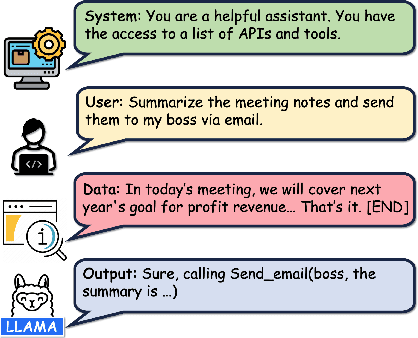



Abstract:Large Language Models (LLMs) are susceptible to security and safety threats, such as prompt injection, prompt extraction, and harmful requests. One major cause of these vulnerabilities is the lack of an instruction hierarchy. Modern LLM architectures treat all inputs equally, failing to distinguish between and prioritize various types of instructions, such as system messages, user prompts, and data. As a result, lower-priority user prompts may override more critical system instructions, including safety protocols. Existing approaches to achieving instruction hierarchy, such as delimiters and instruction-based training, do not address this issue at the architectural level. We introduce the Instructional Segment Embedding (ISE) technique, inspired by BERT, to modern large language models, which embeds instruction priority information directly into the model. This approach enables models to explicitly differentiate and prioritize various instruction types, significantly improving safety against malicious prompts that attempt to override priority rules. Our experiments on the Structured Query and Instruction Hierarchy benchmarks demonstrate an average robust accuracy increase of up to 15.75% and 18.68%, respectively. Furthermore, we observe an improvement in instruction-following capability of up to 4.1% evaluated on AlpacaEval. Overall, our approach offers a promising direction for enhancing the safety and effectiveness of LLM architectures.
Certifiably Robust RAG against Retrieval Corruption
May 24, 2024Abstract:Retrieval-augmented generation (RAG) has been shown vulnerable to retrieval corruption attacks: an attacker can inject malicious passages into retrieval results to induce inaccurate responses. In this paper, we propose RobustRAG as the first defense framework against retrieval corruption attacks. The key insight of RobustRAG is an isolate-then-aggregate strategy: we get LLM responses from each passage in isolation and then securely aggregate these isolated responses. To instantiate RobustRAG, we design keyword-based and decoding-based algorithms for securely aggregating unstructured text responses. Notably, RobustRAG can achieve certifiable robustness: we can formally prove and certify that, for certain queries, RobustRAG can always return accurate responses, even when the attacker has full knowledge of our defense and can arbitrarily inject a small number of malicious passages. We evaluate RobustRAG on open-domain QA and long-form text generation datasets and demonstrate its effectiveness and generalizability across various tasks and datasets.
Position Paper: Beyond Robustness Against Single Attack Types
May 02, 2024Abstract:Current research on defending against adversarial examples focuses primarily on achieving robustness against a single attack type such as $\ell_2$ or $\ell_{\infty}$-bounded attacks. However, the space of possible perturbations is much larger and currently cannot be modeled by a single attack type. The discrepancy between the focus of current defenses and the space of attacks of interest calls to question the practicality of existing defenses and the reliability of their evaluation. In this position paper, we argue that the research community should look beyond single attack robustness, and we draw attention to three potential directions involving robustness against multiple attacks: simultaneous multiattack robustness, unforeseen attack robustness, and a newly defined problem setting which we call continual adaptive robustness. We provide a unified framework which rigorously defines these problem settings, synthesize existing research in these fields, and outline open directions. We hope that our position paper inspires more research in simultaneous multiattack, unforeseen attack, and continual adaptive robustness.
PatchCURE: Improving Certifiable Robustness, Model Utility, and Computation Efficiency of Adversarial Patch Defenses
Oct 19, 2023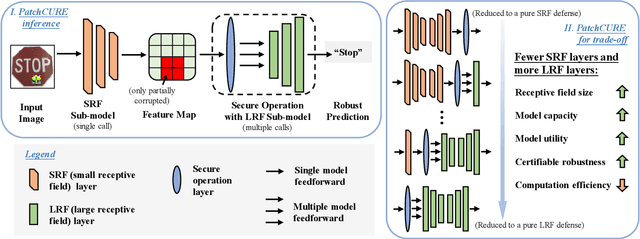

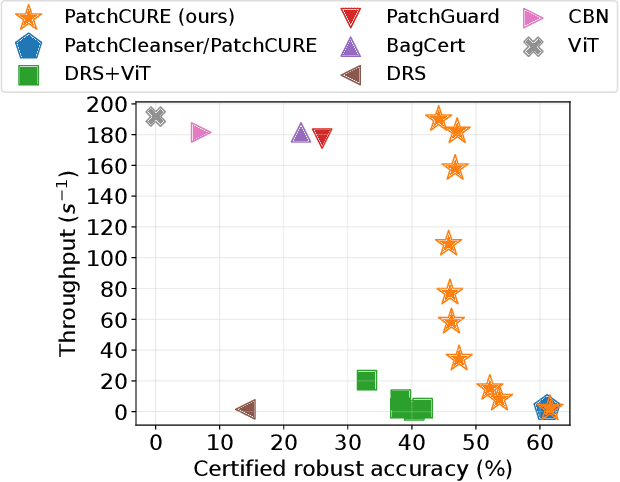

Abstract:State-of-the-art defenses against adversarial patch attacks can now achieve strong certifiable robustness with a marginal drop in model utility. However, this impressive performance typically comes at the cost of 10-100x more inference-time computation compared to undefended models -- the research community has witnessed an intense three-way trade-off between certifiable robustness, model utility, and computation efficiency. In this paper, we propose a defense framework named PatchCURE to approach this trade-off problem. PatchCURE provides sufficient "knobs" for tuning defense performance and allows us to build a family of defenses: the most robust PatchCURE instance can match the performance of any existing state-of-the-art defense (without efficiency considerations); the most efficient PatchCURE instance has similar inference efficiency as undefended models. Notably, PatchCURE achieves state-of-the-art robustness and utility performance across all different efficiency levels, e.g., 16-23% absolute clean accuracy and certified robust accuracy advantages over prior defenses when requiring computation efficiency to be close to undefended models. The family of PatchCURE defenses enables us to flexibly choose appropriate defenses to satisfy given computation and/or utility constraints in practice.
MultiRobustBench: Benchmarking Robustness Against Multiple Attacks
Feb 21, 2023Abstract:The bulk of existing research in defending against adversarial examples focuses on defending against a single (typically bounded Lp-norm) attack, but for a practical setting, machine learning (ML) models should be robust to a wide variety of attacks. In this paper, we present the first unified framework for considering multiple attacks against ML models. Our framework is able to model different levels of learner's knowledge about the test-time adversary, allowing us to model robustness against unforeseen attacks and robustness against unions of attacks. Using our framework, we present the first leaderboard, MultiRobustBench, for benchmarking multiattack evaluation which captures performance across attack types and attack strengths. We evaluate the performance of 16 defended models for robustness against a set of 9 different attack types, including Lp-based threat models, spatial transformations, and color changes, at 20 different attack strengths (180 attacks total). Additionally, we analyze the state of current defenses against multiple attacks. Our analysis shows that while existing defenses have made progress in terms of average robustness across the set of attacks used, robustness against the worst-case attack is still a big open problem as all existing models perform worse than random guessing.
ObjectSeeker: Certifiably Robust Object Detection against Patch Hiding Attacks via Patch-agnostic Masking
Feb 03, 2022



Abstract:Object detectors, which are widely deployed in security-critical systems such as autonomous vehicles, have been found vulnerable to physical-world patch hiding attacks. The attacker can use a single physically-realizable adversarial patch to make the object detector miss the detection of victim objects and completely undermines the functionality of object detection applications. In this paper, we propose ObjectSeeker as a defense framework for building certifiably robust object detectors against patch hiding attacks. The core operation of ObjectSeeker is patch-agnostic masking: we aim to mask out the entire adversarial patch without any prior knowledge of the shape, size, and location of the patch. This masking operation neutralizes the adversarial effect and allows any vanilla object detector to safely detect objects on the masked images. Remarkably, we develop a certification procedure to determine if ObjectSeeker can detect certain objects with a provable guarantee against any adaptive attacker within the threat model. Our evaluation with two object detectors and three datasets demonstrates a significant (~10%-40% absolute and ~2-6x relative) improvement in certified robustness over the prior work, as well as high clean performance (~1% performance drop compared with vanilla undefended models).
PatchCleanser: Certifiably Robust Defense against Adversarial Patches for Any Image Classifier
Aug 20, 2021



Abstract:The adversarial patch attack against image classification models aims to inject adversarially crafted pixels within a localized restricted image region (i.e., a patch) for inducing model misclassification. This attack can be realized in the physical world by printing and attaching the patch to the victim object and thus imposes a real-world threat to computer vision systems. To counter this threat, we propose PatchCleanser as a certifiably robust defense against adversarial patches that is compatible with any image classifier. In PatchCleanser, we perform two rounds of pixel masking on the input image to neutralize the effect of the adversarial patch. In the first round of masking, we apply a set of carefully generated masks to the input image and evaluate the model prediction on every masked image. If model predictions on all one-masked images reach a unanimous agreement, we output the agreed prediction label. Otherwise, we perform a second round of masking to settle the disagreement, in which we evaluate model predictions on two-masked images to robustly recover the correct prediction label. Notably, we can prove that our defense will always make correct predictions on certain images against any adaptive white-box attacker within our threat model, achieving certified robustness. We extensively evaluate our defense on the ImageNet, ImageNette, CIFAR-10, CIFAR-100, SVHN, and Flowers-102 datasets and demonstrate that our defense achieves similar clean accuracy as state-of-the-art classification models and also significantly improves certified robustness from prior works. Notably, our defense can achieve 83.8% top-1 clean accuracy and 60.4% top-1 certified robust accuracy against a 2%-pixel square patch anywhere on the 1000-class ImageNet dataset.
PatchGuard++: Efficient Provable Attack Detection against Adversarial Patches
Apr 26, 2021
Abstract:An adversarial patch can arbitrarily manipulate image pixels within a restricted region to induce model misclassification. The threat of this localized attack has gained significant attention because the adversary can mount a physically-realizable attack by attaching patches to the victim object. Recent provably robust defenses generally follow the PatchGuard framework by using CNNs with small receptive fields and secure feature aggregation for robust model predictions. In this paper, we extend PatchGuard to PatchGuard++ for provably detecting the adversarial patch attack to boost both provable robust accuracy and clean accuracy. In PatchGuard++, we first use a CNN with small receptive fields for feature extraction so that the number of features corrupted by the adversarial patch is bounded. Next, we apply masks in the feature space and evaluate predictions on all possible masked feature maps. Finally, we extract a pattern from all masked predictions to catch the adversarial patch attack. We evaluate PatchGuard++ on ImageNette (a 10-class subset of ImageNet), ImageNet, and CIFAR-10 and demonstrate that PatchGuard++ significantly improves the provable robustness and clean performance.
Improving Adversarial Robustness Using Proxy Distributions
Apr 19, 2021

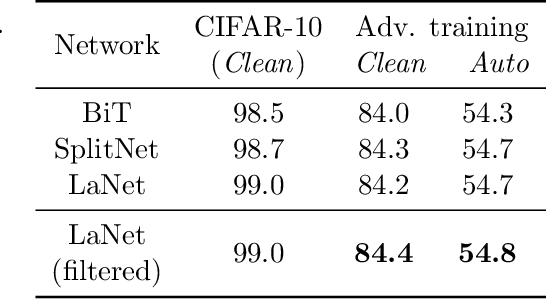
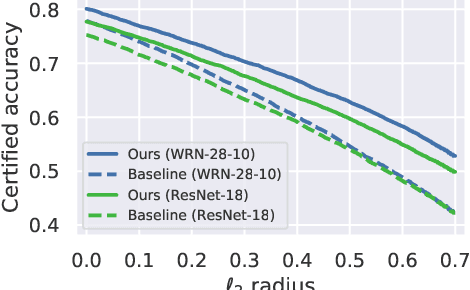
Abstract:We focus on the use of proxy distributions, i.e., approximations of the underlying distribution of the training dataset, in both understanding and improving the adversarial robustness in image classification. While additional training data helps in adversarial training, curating a very large number of real-world images is challenging. In contrast, proxy distributions enable us to sample a potentially unlimited number of images and improve adversarial robustness using these samples. We first ask the question: when does adversarial robustness benefit from incorporating additional samples from the proxy distribution in the training stage? We prove that the difference between the robustness of a classifier on the proxy and original training dataset distribution is upper bounded by the conditional Wasserstein distance between them. Our result confirms the intuition that samples from a proxy distribution that closely approximates training dataset distribution should be able to boost adversarial robustness. Motivated by this finding, we leverage samples from state-of-the-art generative models, which can closely approximate training data distribution, to improve robustness. In particular, we improve robust accuracy by up to 6.1% and 5.7% in $l_{\infty}$ and $l_2$ threat model, and certified robust accuracy by 6.7% over baselines not using proxy distributions on the CIFAR-10 dataset. Since we can sample an unlimited number of images from a proxy distribution, it also allows us to investigate the effect of an increasing number of training samples on adversarial robustness. Here we provide the first large scale empirical investigation of accuracy vs robustness trade-off and sample complexity of adversarial training by training deep neural networks on 2K to 10M images.
 Add to Chrome
Add to Chrome Add to Firefox
Add to Firefox Add to Edge
Add to Edge